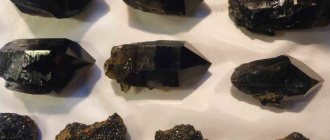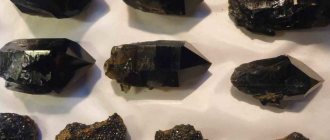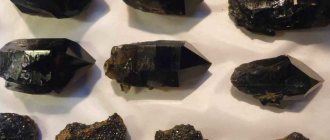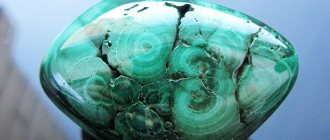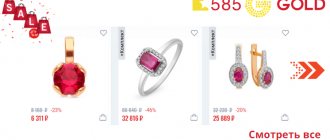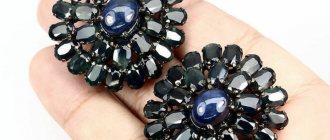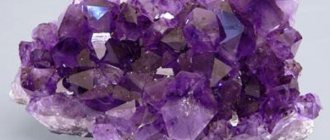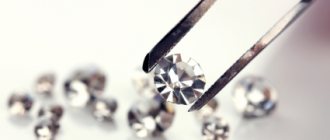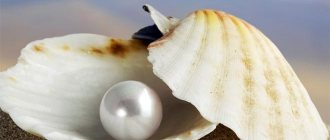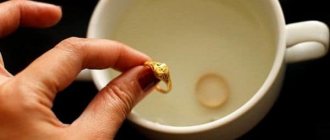Jade, sultanite, malachite, onyx - nowadays you will see more fakes under these names than natural beads. Unfortunately, more and more unscrupulous sellers are appearing - some due to their incompetence and insufficient level of knowledge, some, in order to make more profit, sell their cheaper analogues and imitations under the guise of expensive stones. In this article we will talk about the most common imitations on the market for ornamental stones today and show how to determine the authenticity of a stone.
Sultanite.
The most popular stone in terms of counterfeiting is now sultanite (also known as diaspora or zultanite), beads and products with which have filled not only Turkish shops, but also Russian shops. But you need to understand that this is a very rare, expensive stone, and therefore products with natural sultanites are piece items, not serial products. Sultanites are extremely rarely pure and transparent; more often they contain many nebulae and inclusions; almost colorless crystals are also found. Natural specimens are olive green; depending on the type and brightness of lighting, they change color to orange-green or pinkish-green. Sultanite has a pronounced alexandrite effect - olive and blue-green notes appear under artificial light, and pink and lilac shades are visible under sunlight. The shine of the stone is glassy, with pearlescent reflections.
To meet demand, natural sultanite is not only replaced with synthetic one, but also fake glass is actively sold. Imitations made of glass are brighter, and when the lighting changes, they change color more than natural ones (for example, a radical change in color from green to red or orange is possible). Such synthetic “stones” do not have microcracks and mineral inclusions, “nebula” and cleavage. Also, the price of laboratory stones is quite high due to complex growing technologies, which cannot be said about glass fakes.
Natural diaspore (zultanite)
They have long learned to make color-changing glass by adding a mixture of rare earth element oxides to the glass mass. For example, a well-known Austrian company makes glass beads and inserts using this technology. The technology is simple and there are now many fakes on the market for alexandrites and sultanites with a characteristic color change when the lighting changes.
All glass “stones” are the same shade, clean, transparent, have no inclusions, and there are some air bubbles. The color change is obvious and the same for all beads.
The most common fakes of sultanite now.
Aqua-quartz and other colored glass in pieces and cut
You've probably seen clear, bright, matte beads in pieces and cuts sold as aqua quartz. It is popular, especially in summer, as the beads are colorful and large, but in fact it is ordinary glass. To determine whether it is glass or painted beads of quartz or chalcedony, take a closer look at the beads - natural stone will retain its texture and may contain internal inclusions, while glass will be absolutely monochromatic, while maintaining the texture of broken glass.
On the left is “aqua-quartz”, on the right is apatite, which it imitates externally
It is also worth clarifying that in nature there are no such shades of either quartz or chalcedony. It is always the work of human hands. Such glass is sold painted in different colors that are not typical for natural samples.
On the left is “aqua-quartz”, on the right is fluorite, which it externally imitates
If such quartz does not exist in nature, then what can imitate such glass? For example, raw garnet, aquamarine or apatite.
On the left is painted glass, on the right is natural garnet
Ways to help distinguish a real stone from a fake at home
Natural stones are created by nature, so they have unique features. Man, in turn, processes natural stone by grinding to obtain a smooth and shiny surface. But cases of fraud are still becoming more common. It is not always possible to turn to experienced experts to recognize a fake. There are methods for examining jewelry at home.
First of all, let's test the jewelry by heating it. Naturally occurring stones are known to heat up slowly without it getting hot.
The next method is a visual inspection using a magnifying glass. Real stones have irregular and curved cracks, while laboratory fakes also have cracks, but they are straight or rounded. Also, on natural jewelry, upon careful inspection, some minor defects and flaws are always observed.
The next thing that will help you recognize a fake is the aroma. If you hold amber on a burning match for a little while, it will begin to emit the smell of resin. If it is not there, then most likely it is a fake. Also, real amber can conduct electricity if rubbed with a piece of wool.
The difference between a real diamond is that it can cut glass. You can try this at home. If the diamond itself is damaged, then it is not real.
Volcanic or cherry quartz
Another glass posing as quartz is pink glass with streaks, which unscrupulous sellers call “cherry quartz.” What you should pay attention to is the hardness (quartz is very difficult to scratch), the unnatural color of the product in fakes indicates its synthetic origin and imitation. If we assume that you bought natural quartz, then the cleavage lines will be clearly visible in it, and paint can be seen in internal inclusions and microcracks, since it is often tinted to make it more saturated. Also, natural quartz will be heavier. Good glass imitations are sometimes made very realistic, but high transparency and unnatural hairy inclusions with air bubbles will always be a sign of a fake.
On the left is glass “Cherry quartz” and on the right is natural quartz with inclusions, which it imitates
Glass “volcanic quartz” has a characteristic hairiness designed to imitate inclusions of hematite and lepidocrocite in natural stone; the shade of such glass is always the same, but of different saturation with different degrees of dilution of dyes. In addition to pink shades, this glass is also made with brown and yellow stains, and the main difference will be the presence of air bubbles in the beads and cabochons.
Fakes "Volcanic quartz"
Fake moonstone and opal made of opalite and coated glass
Opalite is glass that they try to sell under the guise of natural opal or moonstone. Glass with a coating between two glued halves is also often sold under the guise of moonstone.
Coated glass offered as opal or moonstone. Not a synthetic opal.
Natural moonstone has muted transparency, softly shimmers and has areas with blue, yellow, lilac, and iridescent iridescence. In natural moonstone, the internal structure of the mineral is almost always visible. And iridescence is visible only when the stone is turned at a certain angle to the light. Opalite beads are transparent, uniformly colored in a bluish-milky color with yellowish tints and do not contain inclusions (they may contain air bubbles).
On the left is scorch, on the right is natural moonstone
Why is moonstone counterfeited?
It is not difficult to guess why gold is counterfeited and counterfeit silver is also produced. Everything is done for the sake of making money on inattentive and gullible people.
The situation with moonstone is in many ways reminiscent of copying amber, which is not the most expensive mineral, but is still actively copied.
Moonstone is a very beautiful gem. The mineral is also called adularia. It is believed to have healing as well as magical properties. Called a natural indicator. We won't go into details.
Do you have jewelry with moonstone?
Not really
The point is that this gem is actively counterfeited. There are several reasons for this:
- it is a natural resource whose reserves are limited;
- to extract a stone, you need to spend a lot of physical effort, as well as use heavy equipment;
- the material requires special processing conditions, which makes the work difficult and painstaking;
- The breed itself is worth good money.
Quite often, imitation is created artificially. That is, synthetic products are passed off as real moonstone. This is the easiest to do since no excavation is required.
The most valuable is the adularia obtained on the island of Sri Lanka. Its cost is impressive. The stone itself is almost colorless. But when light hits it from inside, it acquires a bluish-sparkling hue.
Natural adularia has a huge number of shades, and therefore it is difficult to replicate them artificially. To make an analogue, glass and plastic are used. The blanks are painted, trying to imitate natural colors.
Onyx
Onyx is another popular stone in terms of the number of fakes. Dyed chalcedony is sold under the guise of black onyx (black onyx does not exist), and calcite is hidden under colored mint and apple green with stripes. The structure of natural onyx is layered, consisting of multi-tonal gray, caramel milky shades, and it is quite heavy in weight. If you see clear, even stripes or completely faded and blurry stripes, feel light weight and a warm surface, it’s a fake.
On the left is natural onyx, on the right is natural calcite sold under its guise.
Natural onyx beads in ball and free form
Also, many people mistakenly sell dyed chalcedony as black agate, although neither black nor white agate exists. So under white agate they sell, at best, marble, bleached compacts, chalcedony, but more often glass.
fakes - “Black and white agates”
An application that will help you determine the name of a mineral
Some stones are classified as minerals, so this application will also help you find the name of the stone. This encyclopedia is not inferior in completeness to the database described above, but surpasses it in functionality.
So, its functions are as follows:
- Search form.
- Ability to mark minerals as favorites.
- Different sorting directions.
- List filter.
- The ability to remove any minerals from the list, as well as add your own.
- Several high-quality photos in mineral cards that will help you identify the stone, as well as detailed descriptions, including chemical composition, properties, uses and more.
- It is possible to share the mineral on social networks or messenger.
- The app is free, but there are some ads.
- Russian language is available.
One drawback should be highlighted - the application seems unfinished, since there are non-working buttons, clicking on which will not lead to anything, and sometimes it can take too long. However, despite this, this encyclopedia has a large number of fans and many good reviews.
The application can be downloaded on Android from Google Play using this link. After installation, you can launch it and immediately see a list of minerals with small photos, and list controls - a search form, a button for sorting and filtering.
You can search for your stone using a photo, comparing it with the image in the list. You can enlarge each photo by touching one or another item on the list. There you can also see a more detailed description and more images.
If you have at least an approximate idea of the name of the stone you found, then you can try searching for it in the search form by name. If you can attribute your find to any type, then a filter will help you, which will allow you to divide the list by type of minerals.
By clicking on the plus icon at the bottom right, you can add your mineral. To do this, click on the green button in the menu that opens.
If you click on the red one, you can edit or remove any mineral from the list.
You may be interested in: Identify an object from a photo.
Turquoise - dyed howlite, etc.
Turquoise is definitely among the top counterfeit stones; as soon as a new material was found that could be dyed in a characteristic color, it was processed and inserted into jewelry under the guise of turquoise. The most common materials used for this were dyed howlite, which even in its natural gray color was sold as “immature turquoise,” turquenite, cachalong, magnesite and chrysocolla.
Natural turquoise has a certain hardness, density, color, luminescence, waxy luster, as well as a characteristic structure that can only be seen under a microscope - a light blue background is decorated with dark blue discs, as well as small particles of white shades. In artificial turquoise, bluish particles predominate. One of the main characteristics of natural turquoise is the size of the stone; in nature, pure turquoise is found in small pieces (for example, turquoise the size of a walnut is considered very rare). Large stones are colored unevenly - so if you have a large stone with a uniform color in front of you, then it is most likely a fake. Another important characteristic is the price: turquoise is a precious stone that is quite rare in nature, so turquoise jewelry cannot be cheap.
What you should pay attention to: a plain, evenly colored stone with dark specks and/or brown veins that look like cracks - a fake howlite; dark spots – magnesite treated with salt or copper; Most often, on chips and in holes, the “stone” will be gray or white, since surface painting is practiced, which does not affect the entire depth of the stone.
On the left is howlite, on the right is natural turquoise
Yandex intelligent search for identifying stones from photos
In order to determine the name of a stone from an image, you can use the algorithms of the Yandex search engine. And unlike the methods described above, here you do not have to compare the stone with photo samples yourself. The search engine will do this for you. But, as with any machine, there is a small chance of error and inaccuracy.
In order to recognize a stone from a photo, you will need a smartphone or tablet running Android or iOS.
The procedure for determining the name of a gemstone from a photograph:
- Download the Yandex application with Alice and install it on your device - links for Android and iOS. Open it and you will see the main page. Then you can go in two ways - search in the Yandex image search or search together with Alice.
- To search by image, in the search form, click on the camera icon.
- The camera will open. Point the lens at the stone whose name you want to know and take a photo by pressing the yellow button. Or upload a photo from your device gallery using the button at the bottom right. The photo should be in good light, and preferably there should be no other objects in it.
- After uploading the photo, Yandex will find similar images and from them you will understand what kind of stone is in front of you.
- To search using Alice, click on her icon in the bottom center.
- Click on the camera icon.
- Take a photo of the mineral using the camera that opens, or upload an image from the gallery. Also try to take the highest quality photo possible.
- As a result, Alice will voice the result of the analysis and name the name of the stone, as well as provide useful links to it.
Aventurine
Most often, aventurine glass is sold under the guise of natural aventurine - an imitation of quartzite, which is obtained by adding copper and iron oxides (red-brown “aventurine”), chromium oxides (green), and cobalt oxides (blue) to the molten glass mass. An excessive amount of glitter usually indicates imitation. In glass imitation, the scales can sometimes be unevenly distributed, and zones of colored glass with a reduced glitter content or without them at all can be observed.
The color of natural stone is white, light gray, honey, pink, brick, cherry, green. Saturated colors are not uncommon, but sparkles in natural aventurine are rare. Aventurine glass has an excessive amount of shiny inclusions; in natural aventurine this shiny pollen is not so pronounced.
On the left is a glass fake, on the right is natural aventurine
Chrysoprase
Instead of the much more expensive chrysoprase, dyed chalcedony is often sold. Signs by which a fake can be distinguished are color and uniformity of coloring. Dyed chalcedony is evenly colored over its entire plane and all beads have the same color, color saturation and practically no inclusions, also translucent chalcedony beads have a noticeable cellular growth front (a “honeycomb” structure, which is visible if you look at the stone in the light) . Also, such dyed chalcedony is often much darker than natural chrysoprase. The color of natural chrysoprase is very special: the range of shades is very diverse - from mint transparent with milky areas to rich turquoise green. Chrysoprase is very characterized by picturesque inclusions of the rock in copper-brown, gray-beige tones.
On the left is chrysoprase, on the right is fake
cat's eye
Colored cat's eye beads with even stripes are, of course, also fake. The true mineral chrysoberyl is incredibly rare and expensive, but if its visual properties are what attracts you, then there are other stones that have this visual effect - for example, quartz cat's eye. True, natural stones never have bright open colors: natural chrysoberyl has a gray-olive color scheme, and quartz cat's eye has a gray color. Therefore, there is no alternative to glass borosilicate beads with a “cat’s eye effect” in terms of variety of colors.
On the left is a quartz cat's eye, on the right is a glass imitation cat's eye
How to identify a stone by date of birth and name
Personal codes for a person that are given to him by higher powers include his date of birth. The encoding is not influenced by parents or the birthday person himself.
How to recognize your stone? There are several ways to determine the presented ones:
- month of birth;
- number;
- full date;
- name.
Adherents of occult practices use these numbers to search for magical allies and determine important points on his life path.
How to determine your birthstone by month of birth:
- January - sympathizes with pomegranates, hyacinths, turquoise, cat's eye;
- February - amethysts, pearls, hyacinths, rock crystal, hawk's eye;
- March - aquamarines, heliotropes, jasper, rubies, tourmalines;
- April - diamonds, sapphires, emeralds, agates;
- May - emeralds, agates, carnelian, chalcedony, chrysoprase, tiger's eye;
- June - pearls, alexandrite, agate, turquoise, emerald, aquamarine, chalcedony, cat's eye;
- July - rubies, carnelian, onyx, sardonyx, aventurine, chrysolite;
- August - peridot, alexandrite, sardonyx, topaz, carnelian, moonstone, rubies, citrines;
- September - sapphires, sardonyx, peridot, agate, smoky quartz;
- October - tourmaline, opals, aquamarines, beryls, lapis lazuli, garnets;
- November - topaz, pearls, corals, chrysolites;
- December - zircons, turquoise, heliotropes, rubies, agates, amethysts, chrysoprases.
Minerals by 12 time periods
How to find out what exactly your birthstone is? The search is carried out only by number:
| date | Minerals |
| 1, 10, 19, 28 | coral, opal, topaz, ruby |
| 2, 11, 20, 29 | cat's or tiger's eye, jade, opal, pearl |
| 3, 12, 21, 30 | amethyst, emerald, topaz, coral |
| 4, 13, 22, 31 | aquamarine, garnet, diamond, sapphire, opal |
| 5, 14, 23 | diamond, zircon, light sapphire |
| 6, 15, 24 | beryl, aquamarine, green opal, emerald, peridot |
| 7, 16, 25 | pearl, moonstone, opal, tiger eye |
| 8, 17, 26 | lapis lazuli, opal, sapphire |
| 9, 18, 27 | Coral, garnet, ruby, red opal |
When searching for stones, they are guided by their zodiac sign, date of birth and name.
According to zodiac signs
Malachite
Mainly on the market for fakes in the form of malachite are polymer clay (which is kneaded in a striped form and cut into cabochons or cut into beads) and plastic imitations with stripes. To distinguish a natural stone from an imitation, pay attention to the layering - malachite has smooth lines, the stone is also quite heavy and has a cold surface. There is also often a satin shimmer inside the stone, which can be seen when held up to the light. The colors of the fakes will be quite bright and contrasting, and the design will not create a pleasant pattern, specks and inclusions of chrysocolla or azurite, characteristic of natural malachite.
On the left is fake, on the right is natural malachite
Cacholong
Cacholong is an opaque milky white variety of opal. Although it is found in jewelry, in the natural stone market, unscrupulous sellers sell howlite and bleached magnesite under this name. Natural cacholong has some uneven transparency, especially along the thin edge of the stone. But in howlite and magnesite we will see brownish or gray veins, while in natural cacholong these are dendritic inclusions.
On the left is natural cacholong, on the right is howlite
"Watermelon" tourmaline
The popular watermelon tourmaline is a common target of imitators. The resulting imitation stones often consist of a thin slab of colored glass or plastic glued between two pieces of colored glass. Imitation can be easily determined using a microscope or magnifying glass. If you examine the stones along the belt, you can see the edge of the color plate or glue lines. Sometimes glue bubbles are visible even to the naked eye.
On the left is natural “watermelon” tourmaline, on the right is imitation
But the most common fakes are simple painted glass, acrylic beads or imitation of cheap pressed stones, zoned pink and green. Natural tourmaline has a characteristic structure that is always visible, even if the stone is completely opaque. And in natural watermelon tourmaline, crystal growth zones with inclusions and a variety of shades are visible.
We hope you find this article helpful. It is impossible to fully reveal all the nuances of this multi-layered topic in one article, so if you still have questions, write in the comments, and we will answer.
Where to check the authenticity of gemstones
Nowadays, every year new technologies are developed and existing technologies for the synthesis and refining of jewelry stones are improved, as a result of which a standard set of gemological equipment for determining a jewelry insert, the nature of its origin and the availability of possible refining methods is not enough.
Therefore, the most reliable way to make sure that your jewelry stones comply with the data declared by the seller is to contact a specialized gemological laboratory, where specialists using professional equipment will diagnose the properties of your stone and answer all your questions.
Author of the publication: I. Yantarny
